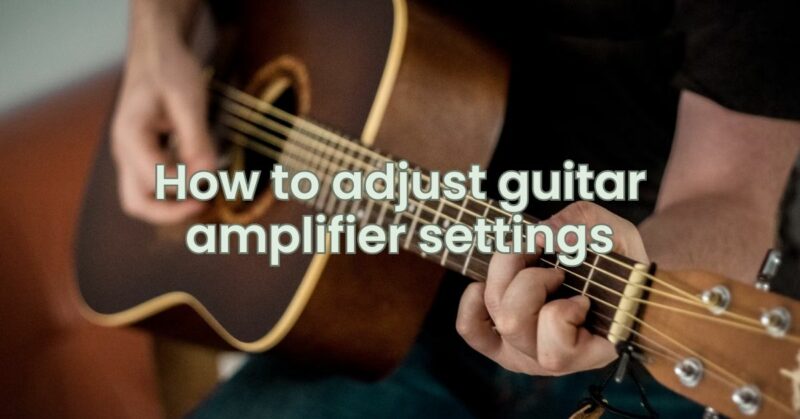As a guitarist, achieving the desired tone and sound from your amplifier is essential for delivering captivating performances and enjoying your playing experience. Understanding how to adjust guitar amplifier settings correctly allows you to unlock the full potential of your equipment and create the perfect sound for your musical style. In this comprehensive guide, we’ll walk you through the various amplifier settings and provide valuable tips to help you achieve the best possible tone.
1. Gain (or Volume): The gain control sets the level of amplification for your guitar signal. Lower gain settings produce cleaner tones, ideal for crisp and articulate playing. Higher gain settings introduce distortion, suitable for genres like rock and metal. Experiment with different gain levels to find the balance that suits your style and playing technique.
2. EQ (Equalization) Controls: Most guitar amplifiers feature three-band EQ controls – Bass, Middle, and Treble. These controls allow you to shape the tone of your guitar sound. Adjust the Bass for low-end frequencies, the Middle for midrange frequencies, and the Treble for high-end frequencies. A balanced EQ setting can make your guitar sound full and well-defined.
3. Presence (or High-frequency Response): The Presence control adjusts the amplifier’s high-frequency response. Turning it up enhances the clarity and brightness of your tone, while reducing it can produce a warmer and smoother sound. Finding the right presence setting depends on your playing environment and personal preferences.
4. Reverb: Reverb adds depth and ambiance to your guitar sound, simulating the effect of playing in a room with natural reflections. Adjust the reverb level to create a sense of space or to achieve the right ambiance for different playing situations.
5. Master Volume: The master volume control sets the overall output level of the amplifier. Use this to control the loudness of your playing, especially in live performances or practice sessions.
6. Effects: Many modern amplifiers come with built-in effects such as delay, chorus, and modulation. These effects can add depth and texture to your sound. Adjust the level of the effects to your liking, but be cautious not to overpower your core guitar tone.
7. Speaker Cabinet and Impulse Responses (IRs): If your amplifier has multiple speaker cabinet options or IR (Impulse Response) simulations, experiment with different options to find the speaker cabinet or IR that complements your guitar and playing style.
Tips for Fine-tuning Your Guitar Amplifier Settings:
- Start with a Neutral Setting: Reset all controls to their mid-position (12 o’clock) to start with a neutral sound. From this point, make gradual adjustments to each setting to understand their impact on your tone.
- Consider Your Guitar and Pickups: Different guitars and pickups have unique tonal characteristics. Adjust your amplifier settings to accommodate the sonic qualities of your specific guitar.
- Room Acoustics: Be mindful of the room’s acoustics when adjusting your amplifier settings. Rooms with hard surfaces may emphasize certain frequencies, affecting your perceived tone.
- Record and Listen: Record your playing with different amplifier settings and listen back critically. This will help you identify which settings work best for your playing style and musical goals.
- Take Your Time: Finding your ideal amplifier settings may require time and experimentation. Don’t rush the process, and enjoy the journey of discovering your perfect tone.
Conclusion:
Adjusting your guitar amplifier settings is an art that enhances your musical expression and brings your guitar playing to life. By understanding each control’s function and making subtle adjustments, you can shape your guitar tone to suit your musical preferences. Remember to experiment, trust your ears, and have fun exploring the vast tonal possibilities your amplifier offers. With practice and patience, you’ll find the sweet spot that makes your guitar sound truly exceptional and unique.


